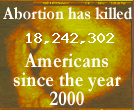It Depends on what the Meaning of "Persistent" Is
Dr. Ronald Cranford was "105 percent sure" of his 1980 diagnosis that Terri Schiavo was in a "Persistent Vegetative State" with no hope of recovery.
What drives a man of science to such hyperbole? I refer not only the supreme arrogance of "105 percent" certainty, but to Cranford's use of "persistent."
Most people regard "persistent" as meaning fixed and unchanging. Such certainty is a bold and dangerous claim to make unless one has absolute clairvoyance to foretell a patient's future. Statistics on PVS patients do not warrant any such degree of certainty, yet Cranford clings relentlessly to his assertions.
He has been proven wrong before.
Consider Minneapolis Police Sgt. David Mack, who was shot in the head by an assailant in 1979 and declared by Dr. Cranford to be in a "persistent vegetative state." Based on Cranford's diagnosis, Mack's family removed him from his respirator, but Mack continued breathing. 18 months after Cranford declared all hope lost, Mack awoke from his coma and began responding to family members, writing answers on paper. Mack has since recovered about 95 percent of his intellectual capabilities and can understand everything said to him.
A Cybercast News Service writer states:
It appears, then, that Cranford's definition of "persistent" is, "at the time I said that." His definition of "accurate" he took from Dan Rather.
The American Academy of Neurology's defition of "persistent vegetative state" includes a statement that "recovery of consciousness from post-traumatic PVS after 12 months in adults and children is unlikely. Recovery from non-traumatic PVS after 3 months is exceedingly rare."
"Unlikely" and "rare" are the prognoses for recovery. The AAN then adds, "as with all clinical diagnoses in medicine, based on probabilities, not absolutes."
The AAN obviously lacks Cranford's audacity. Keeping in mind the case of Sgt. David Mack, apply Cranford's "105 percent certainty" to the following additional cases reported by CNS:
Marcello Manunza: Suffered brain injury during car crash in November 1987. Three years later, began following relatives with his eyes. Within days was able to eat, control the movement of his limbs and speak.
Peter Sana: Lapsed into coma after contracting meningitis. Recovered after seven years. Caregivers credit visits by family members with giving Sana the will to wake up.
Conley Holbrook: Beaten unconscious on Nov. 27, 1982. Eight years later, woke from a PVS, speaking. He then identified his assailants.
Patti White Bull: Diagnosed PVS due to complications from a Caesarean section. Removed from artificial life support two months later. [Important Note: Food and water continued.] Recovered 18 years later on Christmas Day, asking to see her children. A day later, she was walking around her nursing home room with assistance.
CNS further adds:
"A 1996 study published in the British Medical Journal found that 43 percent of patients in the United Kingdom thought to be in a PVS had been misdiagnosed. Of the 40 patients whose cases were reviewed, 17 were later found to be 'alert, aware and often able to express a simple wish.'"
"A 1993 study of 49 patients found that 18 of them, or 37 percent, 'were diagnosed inaccurately.'"
My wife and I have a good friend who suffered a devastating head injury eight years ago and was given a grim prognosis. His complete recovery of his physical and cognitive abilities has been called "miraculous," and also a testament to the incredible power of the brain and nervous system to "rewire itself." No doctor can explain how this happens.
Dr. Cranford, with all due respect, you do not know the recuperative powers of the brain, so stop pretending that you do.
According to Terri Schiavo's friends, Terri said, "Where there is life, there is hope." (This of course contradicts the testimony of her faithless, vindictive, adulterous husband who wanted her dead but in the eyes of Judge Greer was the only credible witness in her case.)
Cranford has established himself as a destroyer of hope and a destroyer of life. Abandoning any pretense of scientific method, he spouts speculation and hypothesis as fact, silences dissent with insults, declares himself omnitient, disallowing or disregarding tests of his theories before he destroys the evidence.
He paints his opponents as ignorant fanatics, refusing to consider any opinion but his own. He denies consensus within the medical community. He himself has taken the "right to die" debate out of the realm of reason and science and, with the help of sympathetic judges, made his edicts law. As a doctor, Cranford has lost all professional objectivity. He is an activist with an agenda, and for humanity's sake, I pray God will raise up the bold scientists who will take him on.
Follow-up: Another case in point - Injured Firefighter Recovers After Almost 10 Years. Explain this one, Dr. Cranford!
What drives a man of science to such hyperbole? I refer not only the supreme arrogance of "105 percent" certainty, but to Cranford's use of "persistent."
Most people regard "persistent" as meaning fixed and unchanging. Such certainty is a bold and dangerous claim to make unless one has absolute clairvoyance to foretell a patient's future. Statistics on PVS patients do not warrant any such degree of certainty, yet Cranford clings relentlessly to his assertions.
He has been proven wrong before.
Consider Minneapolis Police Sgt. David Mack, who was shot in the head by an assailant in 1979 and declared by Dr. Cranford to be in a "persistent vegetative state." Based on Cranford's diagnosis, Mack's family removed him from his respirator, but Mack continued breathing. 18 months after Cranford declared all hope lost, Mack awoke from his coma and began responding to family members, writing answers on paper. Mack has since recovered about 95 percent of his intellectual capabilities and can understand everything said to him.
A Cybercast News Service writer states:
"In an interview last week with Cybercast News Service, Cranford acknowledged a 'mistake,' but maintained that his original assessment of Mack was accurate."
"'At the time I said that, he was in a vegetative state,' Cranford said. 'But, I did make that misstatement about Sgt. Mack and I was wrong and I did make a mistake in that case.'"
It appears, then, that Cranford's definition of "persistent" is, "at the time I said that." His definition of "accurate" he took from Dan Rather.
The American Academy of Neurology's defition of "persistent vegetative state" includes a statement that "recovery of consciousness from post-traumatic PVS after 12 months in adults and children is unlikely. Recovery from non-traumatic PVS after 3 months is exceedingly rare."
"Unlikely" and "rare" are the prognoses for recovery. The AAN then adds, "as with all clinical diagnoses in medicine, based on probabilities, not absolutes."
The AAN obviously lacks Cranford's audacity. Keeping in mind the case of Sgt. David Mack, apply Cranford's "105 percent certainty" to the following additional cases reported by CNS:
Marcello Manunza: Suffered brain injury during car crash in November 1987. Three years later, began following relatives with his eyes. Within days was able to eat, control the movement of his limbs and speak.
Peter Sana: Lapsed into coma after contracting meningitis. Recovered after seven years. Caregivers credit visits by family members with giving Sana the will to wake up.
Conley Holbrook: Beaten unconscious on Nov. 27, 1982. Eight years later, woke from a PVS, speaking. He then identified his assailants.
Patti White Bull: Diagnosed PVS due to complications from a Caesarean section. Removed from artificial life support two months later. [Important Note: Food and water continued.] Recovered 18 years later on Christmas Day, asking to see her children. A day later, she was walking around her nursing home room with assistance.
CNS further adds:
"A 1996 study published in the British Medical Journal found that 43 percent of patients in the United Kingdom thought to be in a PVS had been misdiagnosed. Of the 40 patients whose cases were reviewed, 17 were later found to be 'alert, aware and often able to express a simple wish.'"
"A 1993 study of 49 patients found that 18 of them, or 37 percent, 'were diagnosed inaccurately.'"
My wife and I have a good friend who suffered a devastating head injury eight years ago and was given a grim prognosis. His complete recovery of his physical and cognitive abilities has been called "miraculous," and also a testament to the incredible power of the brain and nervous system to "rewire itself." No doctor can explain how this happens.
Dr. Cranford, with all due respect, you do not know the recuperative powers of the brain, so stop pretending that you do.
According to Terri Schiavo's friends, Terri said, "Where there is life, there is hope." (This of course contradicts the testimony of her faithless, vindictive, adulterous husband who wanted her dead but in the eyes of Judge Greer was the only credible witness in her case.)
Cranford has established himself as a destroyer of hope and a destroyer of life. Abandoning any pretense of scientific method, he spouts speculation and hypothesis as fact, silences dissent with insults, declares himself omnitient, disallowing or disregarding tests of his theories before he destroys the evidence.
He paints his opponents as ignorant fanatics, refusing to consider any opinion but his own. He denies consensus within the medical community. He himself has taken the "right to die" debate out of the realm of reason and science and, with the help of sympathetic judges, made his edicts law. As a doctor, Cranford has lost all professional objectivity. He is an activist with an agenda, and for humanity's sake, I pray God will raise up the bold scientists who will take him on.
Follow-up: Another case in point - Injured Firefighter Recovers After Almost 10 Years. Explain this one, Dr. Cranford!



0 Comments:
Post a Comment
<< Home